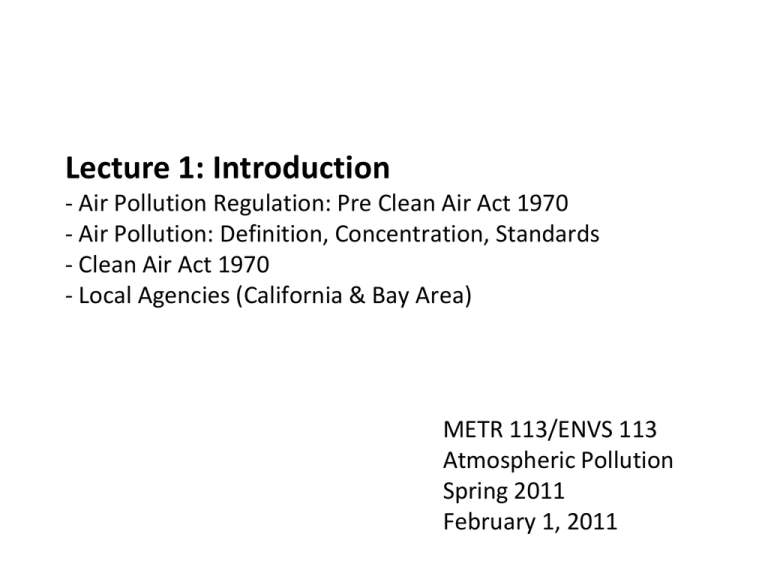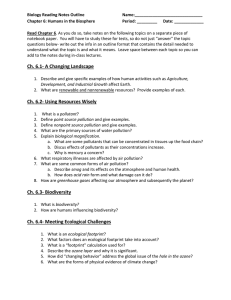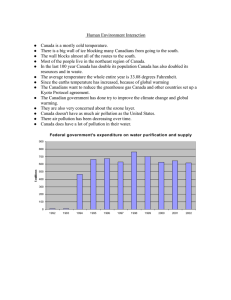
Lecture 1: Introduction
- Air Pollution Regulation: Pre Clean Air Act 1970
- Air Pollution: Definition, Concentration, Standards
- Clean Air Act 1970
- Local Agencies (California & Bay Area)
METR 113/ENVS 113
Atmospheric Pollution
Spring 2011
February 1, 2011
Reading
• Other recommended texts …
― Atmospheric Pollution: History, Science, Regulation by Mark Z. Jacobson.
― Earth Under Siege: From Air Pollution to Climate Change by Richard P. Turco.
Both are on course reserve at King Library. These are comprehensive air
pollution texts with technical details.
• http://www.ametsoc.org/sloan/cleanair/index.html
• Various links in ensuing slides …
• Familiarize yourself with following websites
– http://www.epa.gov/air/ (U.S. EPA air pollution page)
– http://www.arb.ca.gov (California Air Resources Board)
– http://www.baaqmd.gov (Bay Area Air Quality Management District)
Air Pollution Regulation
(Pre-Clean Air Act 1970)
Noontime, Donora, Pennsylvania,
October 29, 1948
Copyright Photo Archive/Pittsburgh Post-Gazette, 2001. All rights reserved
Los Angeles (1950s)
Hollywood Citizens News Collection, Los Angeles Public Library
Homework
(Have short answer ready for upcoming exam on 2/10/11)
•
•
•
•
What were two pollutants discussed? Why?
Emission sources of these two pollutants?
Key events & episodes …
Working knowledge/timeline of key air pollution
regulations in U.S. prior to Clean Air Act of 1970.
• Refer to notes, ‘ametsoc’ website, Chapters 4.1
and 8.1 of Jacobson text, Chapter 6.1 of Turco
text (see ‘Reading’ slide)
Why study air pollution?
•
•
•
•
•
•
•
Causes health problems
Causes visibility problems
Causes agricultural and plant damage
Causes degradation of buildings
Causes odors
Causes climate change
Various other reasons …
How do air pollution professionals characterize
the various air pollutant species?
•
•
•
•
•
•
•
•
By how they are regulated
By their sources
By their formation mechanism in the atmosphere
By their health effects
By their other effects (aside from health)
By whether they are gas or particle
By whether they are of concern indoor or outdoor
By whether they are of concern in workplace or
non-workplace air.
Air Pollution:
Definitions, Concentration, Standards
Los Angeles (July 23, 2000)
Question: Is this air pollution?
Air Pollution: A Common Working Definition …
“Air pollution occurs when gases or aerosol particles,
emitted anthropogenically, build up in concentrations
sufficiently high to cause direct or indirect damage
to humans, plants, animals, other life forms,
ecosystems, structures, or works of art.”
Air Pollution: A Common Working Definition …
“Air pollution occurs when gases or aerosol particles, emitted anthropogenically,
build up in concentrations sufficiently high to cause direct or indirect damage
to humans, plants, animals, other life forms, ecosystems, structures, or works of art.”
Main things …
Air pollution concentration is the important thing to know …
“Concentrations sufficiently high” implies a concentration threshold
beyond which we can anticipate a realistic possibility of damage to
health, ecosystems, etc …
Threshold is often also called a “level of concern” or “standard”
Relevant Question: Is pollution level below or above threshold?
Air Pollution Concentration
(Two main ways this is expressed…)
• Mass Per Unit Volume
–
–
–
–
–
Mass of air pollutant per cubic meter of air
Used for solid, liquid and gaseous air pollutants
Grams per cubic meter (g/m3)
Milligrams per cubic meter (mg/m3) = 0.001 g/m3
Micrograms per cubic meter (µg/m3) = 0.001 mg/m3 = 1.0 × 10-6 g/m3
–
–
–
–
# of molecules of air pollutant per million molecules of air
Used for gaseous air pollutants
1 part per billion (ppb) = 0.001 ppm
1 part per trillion (ppt) = 0.001 ppb = 1.0 × 10-6 ppm
• Parts Per Million (ppm)
Class Exercise: Part 1 …
• Express the following situations in
terms of the air pollution concentration
(use metric units).
1. 500 mg of carbon monoxide in a 10 ft x 10 ft x
10 ft room
2. 10 milligrams of ozone in a 1000 cubic-meter
warehouse
Note: 10 feet = 3.048 meters
Class Exercise: Part 1 …
• Express the following situations in
terms of the air pollution concentration
(use metric units).
1. 500 mg of carbon monoxide in a 10 ft x 10 ft x
10 ft room = 500 mg/28.3 m3 = 17.7 mg/m3
2. 10 milligrams of ozone in a 1000 cubic-meter
warehouse = 10 mg/1000 m3 = 0.01 mg/m3 =
10 µg/m3
Class Exercise: Part 2 …
• Are the concentration levels of Part 1 of
concern in terms of air pollution?
• For the threshold value, use the lowest
(i.e. most strict) 1-hour concentration
standard for carbon monoxide and
ozone from class handout.
Class Exercise: Part 2 …
• We looked at following situations …
1. 500 mg of carbon monoxide in a 10 ft x 10 ft x 10 ft room
= 17.7 mg/m3. California 1-hour standard for carbon
monoxide is 23 mg/m3. Values are fairly close. Therefore,
yes, carbon monoxide at this concentration level is of
concern in terms of air pollution.
2. 10 milligrams of ozone in a 1000 cubic-meter warehouse
= 10 µg/m3. California 1-hour standard for ozone is 183
µg/m3 & 8-hour standard is 137 µg/m3. Value is much less.
Therefore, no, ozone at this concentration level is not of
concern in terms of air pollution … (see note below).
Note: … unless another standard is introduced that is close in value to 10 µg/m3,
indicating that ozone at this concentration is, in fact, of concern at that concentration level.
Air Pollution Emissions
• Emissions – The amount of pollutant
coming from a pollution source or area
over some time.
• Usually expressed as “annual” emissions;
tons per year, pounds per year, etc …
• Other ways: pounds per day, kilograms per
day, grams per second, milligrams per
second
Simple schematic:
Pollution plume from Coal Combustion Power Plant
(Emissions vs. Concentration)
wind
Sulfur dioxide (SO2)
emissions (tpy)
smokestack
Location of facility
boundary (“fenceline”)
SO2 concentration
at a given location
(µg/m3)
Simple schematic:
Pollution plume from Coal Combustion Power Plant
(Within vs. beyond facility fenceline )
Emissions (tpy)
smokestack
OSHA regulates air
pollution within fenceline
(indoor and outdoor areas
in the workplace)
Facility boundary
(“fenceline”)
EPA regulates air
pollution beyond
fenceline, including
pollution from mobile
sources. But only in
outdoor air beyond
facility fencelines
(“ambient air”).
Clean Air Act 1970 and beyond
Clean Air Act
• Created in 1963
• Amendments in 1970, 77, 90 & 97
• Overview of 1970 Amendments…
National Ambient Air Quality Standards (NAAQS)
National Emission Standards for Hazardous Air Pollutants (NESHAPS)
Creation of U.S. EPA in 1971 to enforce
• Overview of 1990 Amendments
Expand NESHAPs to 189 specific pollutants
Provisions to reduce acid rain
Provisions to reduce emissions that cause ozone depletion (“ozone hole”)
• Links
http://www.epa.gov/history/topics/caa70/11.htm
http://epa.gov/oar/caa/caa_history.html
http://www.epa.gov/air/caa/
National Ambient Air Quality Standards (NAAQS)
Ambient air concentration standards are set
for seven criteria air pollutants.
1.
2.
3.
4.
5.
6.
7.
Sulfur Dioxide (SO2)
Carbon Monoxide (CO)
Nitrogen Dioxide (NO2)
Ozone (O3)
PM10 (particulates < 10 µm diameter)
PM2.5 (particulates < 2.5 µm diameter)
Lead (Pb)
Timeline …
CO
SO2
NO2
Total Suspended
Particles (TSP)
PM10
PM10
PM2.5
Hydrocarbons (HC)
Photochemical
Oxidants
Ozone (O3)
Lead (Pb)
1970
1976
1979 1983
1987
1997
current
Some Prominent Air Pollutants Regulated under NESHAPS
(6 of the list of 189 “Hazardous Air Pollutants”, or HAPS)
• Asbestos: Old building material, insulation …
• Benzene: Vapors from gasoline, oils, paints, etc …
• Formaldehyde: Vinyl siding, particle board, industrial (common indoors)
• Hydrogen Fluoride: Industrial
• Methyl Bromide: Vapors from pesticide application to strawberries
• Vinyl Chloride: Plastics, industrial
About HAPS: “Hazardous Air Pollutants” (HAPs) are a class of air pollutants generally known to
be toxic and/or otherwise harmful to human health if inhaled at high enough concentration
and/or for a long enough period of time. The EPA NESHAPS regulations are therefore geared
towards protection of human health (as with NAAQS, towards sensitive populations) due to
inhalation of these pollutants. However, whereas the seven criteria air pollutants are regulated
according to their concentration in the ambient air and whether this exceeds NAAQS
standards, HAPS are regulated according to their emissions from the source according to
NESHAPS standards.
Looking more closely at the NAAQS …
• Primary standards
Health based
Standards set to be protective for sensitive individuals …
… as opposed to younger, healthier populations.
• Secondary standards
Welfare
Only one is SO2 3-hour standard
• Different NAAQS for different averaging times
1-hr, 3-hr, 8-hr, 24-hr and annual averages.
Averaging times of standards depend on pollutant.
• See chart for standards (in-class handout)
• Note: California has its own standards, independent of NAAQS
• See also http://www.arb.ca.gov/research/aaqs/aaqs.htm
NAAQS: Attainment vs. Non-Attainment
• Non-attainment area (Concentration > Standard)
Sources must use modern emission control technologies.
New sources must offset their anticipated emissions w/ decrease elsewhere.
Offsetting usually carried out by purchase of “emission credits”.
• Attainment area (Concentration < Standard)
Class I areas (National Parks, Wildlife refuges, etc …) - No new sources
Class II & III areas: Some new sources w/ modern emission controls.
New sources in Class II and III areas cannot result in violation of NAAQS nor
cause “serious deterioration” (even if NAAQS is obeyed) in air quality
(Prevention of Serious Deterioration, PSD)
Relevance to Air Permitting: New or expanding facilities that will emit air pollutants above a certain
amount must obtain an EPA Title V “air permit” before beginning operations. Nationally, this is done
through EPA New Source Review guidelines, in California through Environmental Impact Reports
submitted to California EPA are required by CEQA. The air permitting procedure depends on whether
the new or expanding facility will be in an “attainment” or “non-attainment” area. The permit
application must then demonstrate compliance with the requirements in the above bulletpoints (as
well as others) according to whether the facility will be in an attainment of non-attainment area.
Air Pollution Control Agencies Hierarchy (California)
EPA
(National)
California Air Resources Board
(CARB)
Bay Area Air Quality
Management District
(BAAQMD)
EPA Region 9
(California & other states)
South Coast Air Quality
Management District
(SCAQMD)
Others …
Air Quality Management Districts
(http://www.arb.ca.gov/capcoa/roster.htm)
Bay Area Air Quality Management District
Air Pollution Monitoring Sites …
Compliance in the Bay
Area with NAAQS and
California state ambient
air pollution standards
are checked at these sites.
Turns out …
• Bay Area is not in compliance with Ambient
AQ standards (NAAQS and CA standards)
with respect to
– Ozone
– PM10
– PM2.5
• Therefore, Bay Area is a non-attainment
area with respect to ozone, PM10 and
PM2.5
Homework
• Verify the Bay Area is a non-attainment area on previous slide by looking
at data on http://gate1.baaqmd.gov/aqmet/aq.aspx. Print out pages
showing examples of day/time/year/place/ when and where air
concentrations of ozone, PM10 and PM2.5 are not in compliance. Circle
the data point that is not in compliance. Turn this part in before the exam
on Feb. 10.
• Based on your findings, in what parts of the Bay Area, and during what
time of year and time of day, are ozone and PM10/PM2.5 subject to high
concentrations that are not in compliance with AQ standards? Be
prepared to answer this question on the Feb. 10 exam.
Improvements in U.S. Air Quality
(8-Hour Average Carbon Monoxide Concentration)
Improvements in U.S. Air Quality
(Annual Average Nitrogen Dioxide Concentration)
Improvements in U.S. Air Quality
(Annual Average Sulfur Dioxide Concentration)
Improvements in California Air Quality
(MaximumHourly and Annual Average Concentration)
Carbon
Monoxide
Nitrogen
Dioxide
Improvements in California Air Quality
(1-Hour and 8-Hour Ozone Concentrations)
Some Pollutants Not Regulated By Either NAAQS nor NESHAPS
that you may have heard of …
• Chlorofluorocarbons (CFCs), “Freon” Gases
- Ozone Layer depleting gases
- Emissions of CFCs (and other “ozone depleting pollutants”)
regulated in Clean Air Act 1990 Amendments
• Carbon Dioxide, Methane, other “greenhouse gases”
- Believed main cause of global warming …
- Not yet (fully) regulated (!)
- Draft regulation working through EPA/U.S. Congress
- California “Global Warming Solution Act” (AB32) in effect
• Links
- http://www.epa.gov/ozone/strathome.html
- http://www.epa.gov/climatechange/
- http://www.arb.ca.gov/cc/cc.htm
Regulations: EPA & CARB
• Criteria Air Pollutants (seven of them …)
– EPA: NAAQS
– CARB: Separate Standards, usually more stringent (i.e. lower),
some additional pollutants aside from original seven
• Hazardous Air Pollutants (HAPS)
– EPA: NESHAPS on 189 pollutants
– CARB: AB2588 (“Toxic Hot Spot” Reg.), slightly different list of
pollutants that (probably) include original 189 plus some others,
called “toxic air contaminants” (TACs) in CARB lingo.
• Ozone Depleting Pollutants
– EPA: Clean Air Act Amendments 1990
– CARB: ?
• CO2 & other greenhouse gases
– EPA: no finalized regulations, being debated …
– CARB: AB32 “Global Warming Solutions” Act
Practice Questions for Exam #1
Given the following concentration measurements over some
air district in the U.S. for certain air pollutants for a certain year,
what NAAQS are violated (specific pollutant and averaging times)?
Pollutant
(units)
Maximum*
Hourly
Concentration
Maximum*
Daily Average
Concentration
Annual Average
Concentration
CO (µg/m3)
30
20
10
NO2 (ppm)
0.15
0.03
0.02
O3 (ppb)
100
75
40
PM2.5
(µg/m3)
50
30
20
* Maximum over the year
Sample Multiple Choice (1)
Which best characterizes the air quality in the SF bay area? …
a) Non-Attainment with respect to ozone and carbon dioxide ambient air standards
b) Non-Attainment with respect to ozone and PM2.5 ambient air standards
c) Attainment with respect to all ambient air standards except ozone
d) Attainment with respect to all ambient air standards except carbon dioxide
Sample Multiple Choice (2)
Species ‘A’ is a chemical that poses a health risk when inhaled. Based on how
air pollution is defined, which of the following correctly characterizes whether ‘A’
is of concern as an “air pollutant”?
a) The emission rate of ‘A’ is above or near its health risk threshold.
b) The concentration of ‘A’ is above or near its health risk threshold.
c) The emission rate of ‘A’ is non-zero. It does not matter whether this value
is above or near its health risk threshold.
a) The concentration of ‘A’ is non-zero. It does not matter whether this value
is above or near its health risk threshold.






